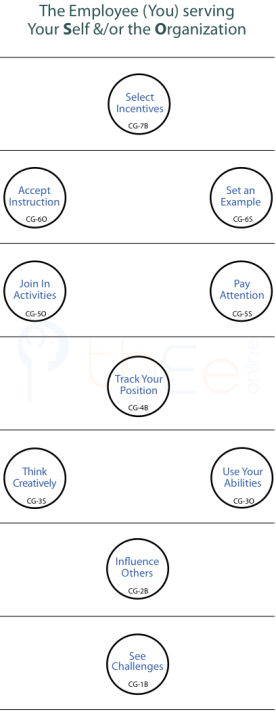Polarize Your Relationship
In by an organization, you must choose whether you focus on serving yourself or on serving the organization. This is the unavoidable inherent tension generated by entering employment.
This polar duality affects choices that you make at each level. Applying the duality to the hierarchy reveals 10 Centres of Choice as shown in the diagram and explained below.
CG1: See Challenges

to orient your work is balanced.![]() Why?
Why?
CG2: Influence Others
in a legitimate way to control work activities is balanced![]() Why?
Why?
CG3: Be Resourceful
, so as to deliver results for the organization at the behest of managers, has two polar Centres.
In so as to deliver results, you recognize a difference between what the organization is seeking and how far your own resourcefulness can contribute.
With a focus on serving the organization, you must for which you were employed and on which your resourcefulness necessarily depends.
However your efforts may be wasted or misdirected e.g. due to poor systems or insufficient resources or management misjudgements. By focusing on serving yourself, you will be inclined to about situations to help you work out what you might do that is useful.
So there are two polar Centres in :
■ : CG3O
■ : CG3S
This raises the issues of which pole will be viewed as dominant by an employee. It makes sense to put creative thinking in the context of using your abilities, without which crucial issues and relevant factors will be hazy. Thinking creatively as if from an independent position, whatever its actual value, is not usually wanted by management. So the organizational focus should dominate for the employee. ![]() See the picture:
See the picture:
CG4: Track Your Position
, using the widest variety of observations and assessments, is balanced.![]() Why?
Why?
CG5: Create a Presence
There are two polar Centres in . This enables you to be flexible in response to management requests and to get special consideration.
By , you can position yourself to be flexible in a way that serves yourself. You also increase your chances of obtaining special consideration from management.
With a focus on the good of the organization, flexibility is expressed by . Activities may be informal (e.g. parties and events, sports days, charitable work) or formal (e.g. strategic timeouts, special training, voluntary projects, workshops, mentoring). Some activities are periodic and routine, others are sporadic.
The focus on one's self calls for at all times to what is going on. This ensures you can articulate your views and needs in ways and at times that ensure you are properly noticed.
So there are two polar Centres in :
■ : CG-5S
■ : CG-5O
This raises the issue of which pole will be viewed as dominant by an employee. Being alert and paying close attention to what is going on are more crucial for an employee than joining in. After all, only by paying attention is it possible to know what activities to join and when and how to participate. So the self pole should dominate. ![]() See the picture:
See the picture:
CG6: Adjust to Developments
There are two polar Centres in to which the organization is committed or by which it is buffeted.
An employee shows commitment by that arise from new rules and policies or reactions to external events. These adjustments may be physical and practical matters, social and relationship, or mental and aspirational. They may be confined to the work-place or impact on domestic life.
Your focus on the organization is expressed in from management on a wide variety of matters. Some instructions may seem trivial (like hairstyle), some may disrupt (like hours of work), and some may almost offend (like peremptory commands that disrupt a near-completed task). Such adjustments are usually evident to others by simple observation.
With a focus on yourself, you should be willing to to others of what the organizations seeks and needs. This sort of adjustment is internally shaped and psychologically manifested. It can be harder for others to perceive. If perceived, it may not be appreciated by some.
So there are two polar Centres in .
■ : CG-6S
■ : CG-6O
This raises the issue of which pole should be viewed as dominant by an employee. is of greater value to an employee not only because it is highly desired by management, but because it enables personal growth. , which is about being a willing follower and part of the staff community, is most effective when it is part of setting an example. So the self pole should dominate. ![]() See the picture:
See the picture:
CG7: Select Incentives
that ensure employment is felt to be satisfactory, is balanced.![]() Why?
Why?
Having applied the dynamic duality, each Centre is primed to influence and interact with others. A disruptive tension is already blatant: CG3, CG5, and CG6. At these levels, there could be a danger of either neglecting yourself or being too self-centred.
- Now: ensure your safe and sensible integration into the organization by linking polar opposite Centres.
OR - Skip this systematic development of Centres and Channels and continue to the end result and what it shows.
- See the equivalent to this page for management .
- Go to a comparison of the and frameworks.
Originally posted: 17-Dec-2011


